Related Research Articles

Confectionery is the art of making confections, which are food items that are rich in sugar and carbohydrates. Exact definitions are difficult. In general, however, confectionery is divided into two broad and somewhat overlapping categories: bakers' confections and sugar confections. The occupation of confectioner encompasses the categories of cooking performed by both the French patissier and the confiseur.
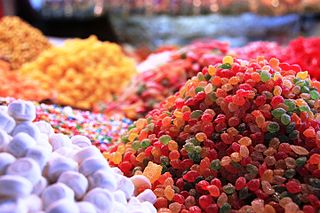
Candy, also called sweets or lollies, is a confection that features sugar as a principal ingredient. The category, called sugar confectionery, encompasses any sweet confection, including chocolate, chewing gum, and sugar candy. Vegetables, fruit, or nuts which have been glazed and coated with sugar are said to be candied.
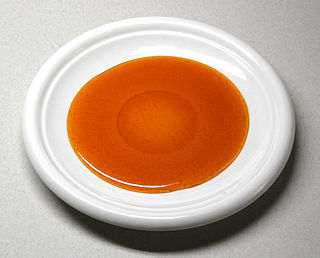
Caramel is an orange-brown confectionery product made by heating a range of sugars. It can be used as a flavoring in puddings and desserts, as a filling in bonbons, or as a topping for ice cream and custard.
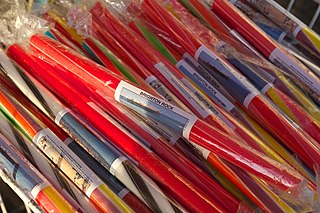
Rock is a type of hard stick-shaped boiled sugar confectionery most usually flavoured with peppermint or spearmint. It is commonly sold at tourist resorts in the United Kingdom and Ireland ; in Gibraltar; in Denmark in towns such as Løkken and Ebeltoft; and in Sydney and Tasmania, Australia.
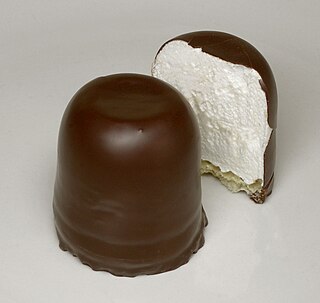
Chocolate-coated marshmallow treats, also known as chocolate teacakes, are confections consisting of a biscuit base topped with marshmallow-like filling and then coated in a hard shell of chocolate. They were invented in Denmark in the 19th century and later also produced and distributed by Viau in Montreal as early as 1901. Some variants of these confections have previously been known in many countries by names comprising equivalents of the English word "negro".

The Heath bar is a candy bar made of toffee, almonds, and milk chocolate, first manufactured by the Heath Brothers Confectionery in 1928. Since its acquisition of the Leaf International North American confectionery operations late in 1996, the Heath bar has been manufactured and distributed by Hershey.

Fudge is a type of confection that is made by mixing sugar, butter and milk. It has its origins in 19th century USA and was popular in the women's colleges of the time. Fudge can come in a variety of flavorings depending on the region or country it was made; popular flavors include fruit, nut, chocolate and caramel. Fudge is often bought as a gift from a gift shop in tourist areas and attractions.
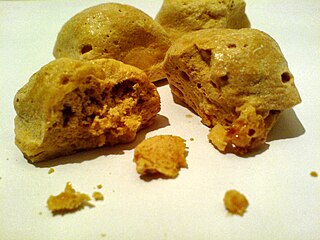
Honeycomb toffee, honeycomb candy, sponge toffee, cinder toffee, seafoam, or hokey pokey is a sugary toffee with a light, rigid, sponge-like texture. Its main ingredients are typically brown sugar and baking soda, sometimes with an acid such as vinegar. The baking soda and acid react to form carbon dioxide which is trapped in the highly viscous mixture. When acid is not used, thermal decomposition of the baking soda releases carbon dioxide. The sponge-like structure is formed while the sugar is liquid, then the toffee sets hard. The candy goes by a variety of names and regional variants.

Nonpareils are a decorative confectionery of tiny balls made with sugar and starch, traditionally an opaque white but now available in many colors. They are also known as hundreds and thousands in Australia, New Zealand, South Africa and the United Kingdom.
Butter Brickle is a chocolate-coated toffee first sold 20 November 1924 by candy manufacturer John G. Woodward Co. of Council Bluffs, Iowa, and toffee pieces for flavoring ice cream, manufactured by The Fenn Bros. Ice Cream and Candy Co. of Sioux Falls, South Dakota.

Mounds is a candy bar made by The Hershey Company, consisting of shredded, sweetened coconut coated in dark chocolate. The company also produces the Almond Joy, a similar bar topped by whole almonds and covered in milk chocolate. The two products share common packaging and logo design, with Mounds using a red color scheme and Almond Joy blue.

Compound chocolate is a product made from a combination of cocoa, vegetable fat and sweeteners. It is used as a lower-cost alternative to true chocolate, as it uses less-expensive hard vegetable fats such as coconut oil or palm kernel oil in place of the more expensive cocoa butter. It may also be known as "compound coating" or "chocolatey coating" when used as a coating for candy. It is often used in less expensive chocolate bars to replace enrobed chocolate on a product.
The following outline is provided as an overview of and topical guide to chocolate:
The superior knowledge doctrine is a principle in United States contract law which states that the government must disclose to a contractor any otherwise unavailable information that is vital to contract performance. It is also referred to as "the Helene Curtis doctrine of superior knowledge.

An enrober is a machine used in the confectionery industry to coat a food item with a coating medium, typically chocolate. Foods that are coated by enrobers include nuts, ice cream, toffee, chocolate bars, biscuits and cookies. Enrobing with chocolate extends a confection's shelf life.
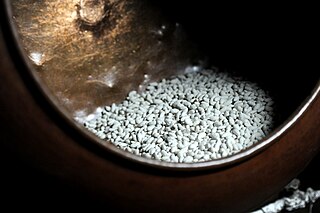
Candy making or candymaking is the preparation and cookery of candies and sugar confections. Candy making includes the preparation of many various candies, such as hard candies, jelly beans, gumdrops, taffy, liquorice, cotton candy, chocolates and chocolate truffles, dragées, fudge, caramel candy, and toffee.
References
- F&F Laboratories, Inc., ASBCA No. 33007, 89-1 BCA ¶ 21,207, 1988 WL 1637187, rev'd, ASBCA No. 33007, 89-1 BCA ¶ 21,207, 1988 WL 104191.
- Federal Specification for Candy and Chocolate Confections, from microfilm stored at the Politecnico di Milano university.